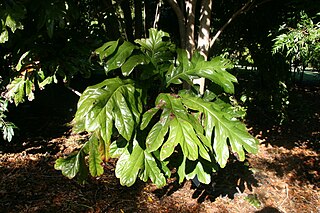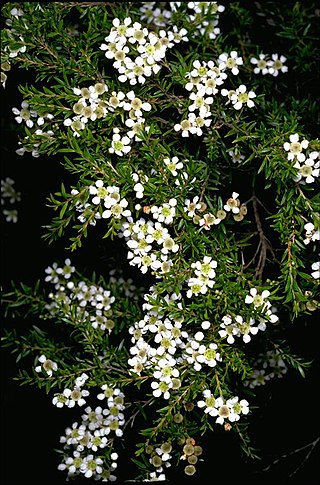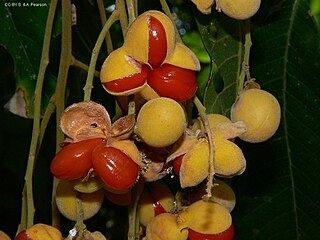
Athertonia is a monotypic genus of plants in the family Proteaceae. The sole described species is Athertonia diversifolia, commonly known as Atherton oak, athertonia, creamy silky oak or white oak. It is endemic to a small part of the Wet Tropics of Queensland, Australia. A relative of the macadamia, it has potential in horticulture and the bushfood industry.

Argophyllum is a genus in the Argophyllaceae family comprising eighteen species of shrubs and small trees. They feature alternate, simple leaves, often silvery white underneath. They appear in Australia and New Caledonia, where several species are nickel hyperaccumulators.

Sannantha similis is a species in the myrtle family, Myrtaceae and is endemic to eastern Australia. It is a shrub with narrowly lance-shaped leaves, and groups of three white flowers arranged in leaf axils.

Opisthiolepis is a monotypic genus of trees in the macadamia family Proteaceae. The sole species is Opisthiolepis heterophylla, commonly known as blush silky oak, pink silky oak, brown silky oak or drunk rabbit. It was first described in 1952 and is endemic to a small part of northeastern Queensland, Australia.

Phebalium longifolium is a species of shrub that is endemic to far north Queensland. It is more or less covered with silvery to rust-coloured scales and has smooth branchlets, narrow elliptical to narrow lance-shaped leaves and cream-coloured flowers in umbels on the ends of branchlets. It grows in the boundary between forest and rainforest in tropical areas.

Gardenia actinocarpa is a rare and endangered plant in the madder family Rubiaceae that grows in a very restricted area within the Wet Tropics rainforest of north-east Queensland.

Cerbera inflata, commonly known as the cassowary plum, grey milkwood, Joojooga, or rubber tree, is a plant in the family Apocynaceae endemic to north east Queensland, specifically the Atherton Tablelands and adjacent areas.

Argophyllum palumense is a plant in the Argophyllaceae family endemic to a small part of north eastern Queensland. It was described and named in 2018.
Argophyllum loxotrichum is a plant in the Argophyllaceae family endemic to a small part of north eastern Queensland. It was described and named in 2018.

Dendrocnide cordifolia, commonly known as the stinging tree, is a plant in the nettle family Urticaceae endemic to the Atherton Tablelands, south west of Cairns, Queensland. Contact with the plant results in a painful sting, however the intensity and duration of the pain from this plant is extreme.
Argophyllum lejourdanii is a plant in the Argophyllaceae family endemic to a part of north eastern Queensland, Australia. It was described and named in 1863.
Argophyllum ferrugineum is a plant in the Argophyllaceae family endemic to a small part of north eastern Queensland. It was described and named in 2018.
Argophyllum heterodontum is a plant in the Argophyllaceae family endemic to a small part of north eastern Queensland. It was described and named in 2018.
Argophyllum iridescens is a plant in the Argophyllaceae family endemic to a small part of north eastern Queensland. It was described and named in 2018.
Dansiea elliptica is a species of rainforest tree which is endemic to Queensland, Australia. The species, which occurs within two highly disjunct centres of distribution, is primarily found in drier notophyll vine forests and semi evergreen vine thickets in the Wet Tropics of Queensland and Central Queensland. The species is listed as Near Threatened under the Queensland Nature Conservation Act (1992) and has a total area of occupancy of less than 40 square km.

Pittosporum ferrugineum, commonly known as the rusty pittosporum or rusty-leaved pittosporum, is an evergreen plant in the family Pittosporaceae native to Malesia, Papuasia, the Northern Territory and Queensland.

Polyosma rhytophloia, commonly known as wrinkled bark polyosma, is a plant in the family Escalloniaceae which is endemic to parts of eastern Queensland, Australia. It is an evergreen small tree growing up to 11 m (36 ft) high. The glabrous (hairless) leaves may be 7 to 12 cm long and 2 to 6 cm wide, with a number of very fine teeth along the margins. The veins are prominent on both sides of the blade, and the midrib is often purple on the underside.

Diploglottis diphyllostegia, commonly known as the northern tamarind, native tamarind or wild tamarind, is a tree in the lychee family Sapindaceae which is endemic to Queensland, Australia. It is an attractive tree with potential in cultivation, with a dense crown of dark green leaves and masses of fruit in spring and summer.

Diploglottis obovata, commonly known as blunt-leaved tamarind, is a plant in the family Sapindaceae endemic to central eastern Queensland, Australia. Until 1987 it was considered to be a form of the very closely related Diploglottis diphyllostegia.

Argophyllum cryptophlebum is a plant in the Argophyllaceae family endemic to a small part of north eastern Queensland. It was described and named in 1907.



















